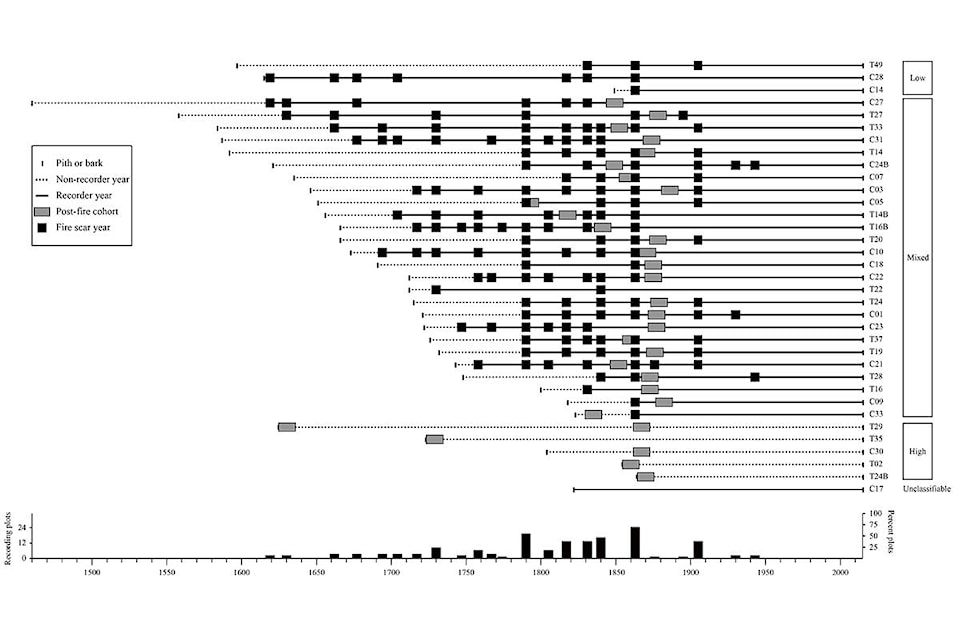New research from the University of British Columbia (UBC) indicates wildfires used to be a lot more common in the Cariboo.
Wesley Brooke is a Master of Science student at UBC who for his thesis has been studying the Knife Creek Block of the Alex Fraser Research Forest, which is on the east hand side of Highway 97 just north of Knife Creek Road and the 140 Mile area.
He’s been examining trees for fire scarring. While the data gets less reliable the further back in time because fewer trees date back that far, Brooke found evidence of 22 fires between 1619 and 1943. The time between the fires varied but averaged one every 15 years.
The last two fires, those post-1905, were both spot fires. Brooke found no evidence of fire after the last spot fire in 1943. The largest fires recorded in the study area were in 1790, 1840 and 1863.
According to Brooke’s supervisor, Dr. Lori Daniels, an associate professor at UBC within the Department of Forest and Conservation Sciences, this has changed the composition of the forest.
“The change from one fire every 15 years to none for many decades is key. Also, that the majority of trees in the forest established in the mid to late 1800s is important too. The majority of the forest is relatively young and many of those trees have survived until now since there were few fires to thin the forest of small/young thin-barked trees. Today’s dense forests are perpetuated by the lack of fires - from land use change (including removing Aboriginal cultural fire from the land), grazing to reduce fuels to carry fire, and fire suppression intended to protect our communities and forest resources.”
“Today’s forest is quite dense and includes trees of a range of sizes that act as ladder fuels. Ladder fuels contribute to wildfires torching and crowning (spreading tree top to tree top) in hot, dry, windy conditions like this summer.”
Daniels adds that this change makes the Cariboo more prone to the types of large fires the Cariboo is experiencing this summer.
“Given the details of change we have reconstructed at Knife Creek and other places in the Cariboo, combined with repeat photographs showing increased forests over the 20th century, we have strong evidence that today’s forested landscapes are more prone to large and severe fires simply because there are more forest and more trees in those forests. Also, historical photos show many (not all but many) towns were once surrounded by grasslands and open woodlands, where denser dry-belt forests now form their wildland urban interface.”
There are three reasons for the absence of fire scarring post-1943, according to Daniels, the lack of surface fires is a big contributor.
“Active fire suppression has become increasingly important during the 20th century, especially after WW2 when modern technology became key in detecting and fighting wildfires. The fires that are most easily suppressed are the surface fires burning in the understory and under milder fire-weather conditions. So we have eliminated the subset of fires that would have maintained open grasslands and woodlands, thinned forests and kept the surface fuels from accumulating. As we are seeing this year, the more vigorous crown fires still burn during extreme fire weather - and did so in the past as well. However, some of the diversity in vegetation types and forest structures across the landscapes of the past may have been lost - more uniform forests would influence the intensity and size of wildfires today.”
A second reason there are fewer (surface) fires is agricultural use, according to Daniels.
“Land-use change, including agriculture and grazing, as Europeans settled in B.C. Grazing by livestock reduces fine fuels that would have carried surface fires. Land clearing and agricultural crops also change the fuels and may have formed fire breaks.”
A third factor, is the removal of Aboriginal cultural fires as part of their traditional land care practices, says Daniels.
“We are currently working with the Williams Lake band to better understand this component of historical fires.”
